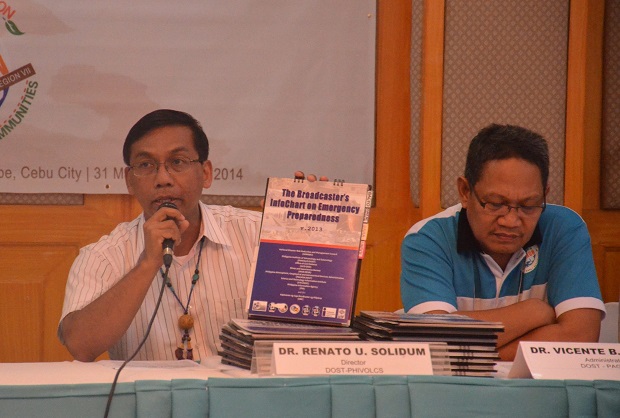
The Philippine Institute for Volcanology and Seismology (PHIVOLCS), under the umbrella of the Department of Science and Technology (DOST), and other partner-agencies organize a disaster awareness and mitigation campaign dubbed as “Iba na ang Panahon! Science for Safer Communities” on March 31-April 1 in Cebu City. PHOTO and CAPTION from PHILVOLCS-DOST Facebook page.
MANILA, Philippines—The nationwide disaster preparedness information campaign led by the Department of Science and Technology will conclude on Thursday the two-day event at the Philippine International Convention Center.
Mayors, disaster risk reduction and city planning officers, as well as local government consultants of the National Capital Region will gather for the final leg of “Iba na ang Panahon (INAP): Science for Safer Communities.”
The project, which started in March 2014, is a collaboration between the DOST, Department of the Interior and Local Government and the Office of Civil Defense.
It is aimed to arm LGUS with disaster information through science-based tools like 3D hazard maps, flood models, Project NOAH website, hazard simulation software, and mobile applications.
DOST Secretary Mario Montejo said in a statement on Wednesday that INAP “embraces the change in our seasonal climate and weather patterns and the severity of the impact of weather-related natural hazards in the country.”
The country is battered with an average of 20 typhoons per year. In the recent years, destructive typhoons hit the country namely Ondoy, Pepeng, Sendong, Pablo and Yolanda. Monsoon rains also caused widespread flooding.
Last year, a massive earthquake hit Bohol that highlighted the need for intensive disaster preparations in the local level.
The participants will be taught on how to use the available information and products from the said initiatives during the workshops and exercises to be conducted and use such information to identify hazards in their own localities such as fault lines, previous flood and storm surge episodes, and other calamities that affected and may still affect their communities, especially in the face of climate change, the DOST said.
The government also stepped up its monitoring capabalities which include the installation of additional doppler radars, water level monitoring sensors, Project NOAH and Lidar mapping.
“Early warning leads to early action,” Montejo said. “If our local leaders are able to act early, then they will be able to minimize loss and lead their communities into early recovery.”
RELATED STORIES
Israelis to hold disaster preparedness trainings in Cebu towns in November
Luzon LGUs’ focus: El Niño, fiercer storms

